
kvpress
LLM KV cache compression made easy
Stars: 600
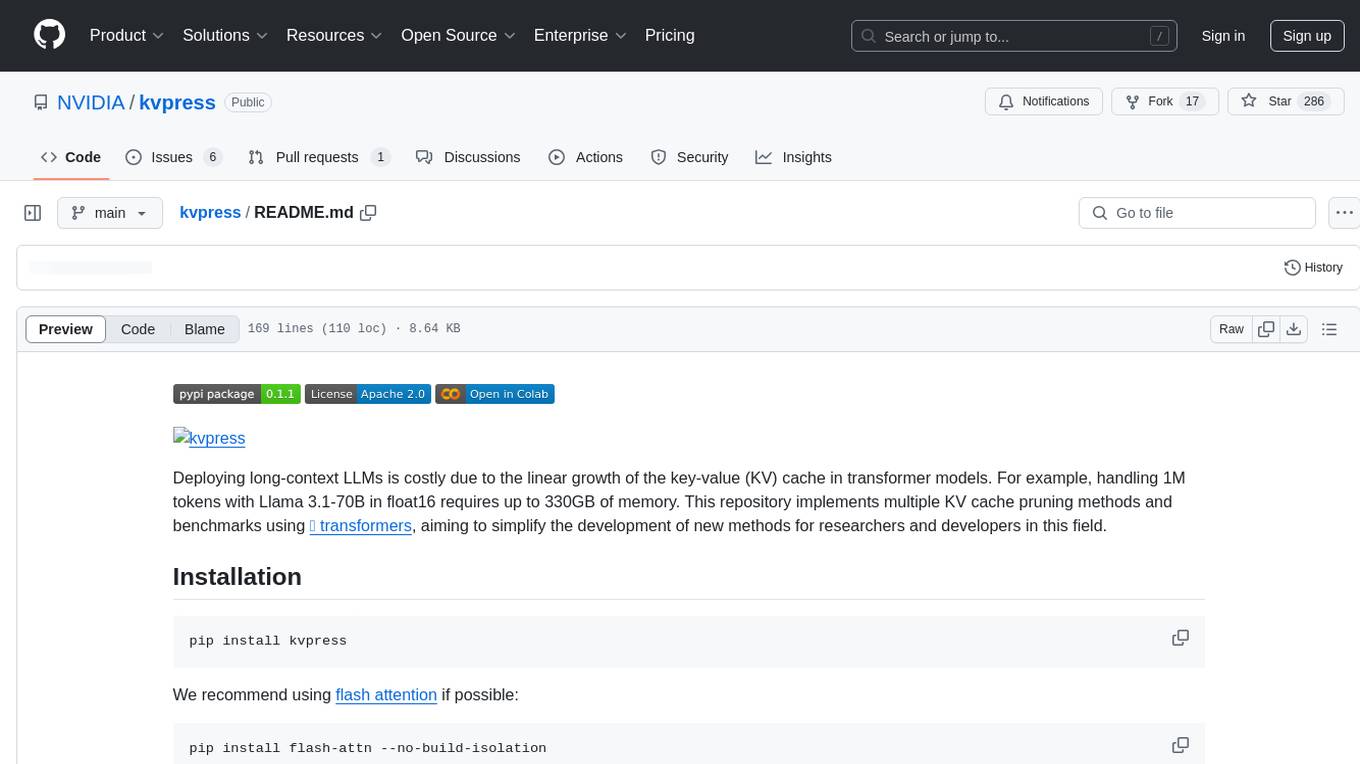
This repository implements multiple key-value cache pruning methods and benchmarks using transformers, aiming to simplify the development of new methods for researchers and developers in the field of long-context language models. It provides a set of 'presses' that compress the cache during the pre-filling phase, with each press having a compression ratio attribute. The repository includes various training-free presses, special presses, and supports KV cache quantization. Users can contribute new presses and evaluate the performance of different presses on long-context datasets.
README:
Deploying long-context LLMs is costly due to the linear growth of the key-value (KV) cache in transformer models. For example, handling 1M tokens with Llama 3.1-70B in float16 requires up to 330GB of memory. kvpress implements multiple KV cache compression methods and benchmarks using 🤗 transformers, aiming to simplify the development of new methods for researchers and developers in this field.
pip install kvpressFor a local installation with all dev dependencies, use uv:
git clone https://github.com/NVIDIA/kvpress.git
cd kvpress
uv sync --all-groupsAdvanced installation settings
To install optional packages, you can use uv. To install with flash attention, just run:
git clone https://github.com/NVIDIA/kvpress.git
cd kvpress
uv sync --extra flash-attnTo install with dependencies for evaluation, run
git clone https://github.com/NVIDIA/kvpress.git
cd kvpress
uv sync --extra evalKVPress provides a set of "presses" that compress the KV cache during the prefilling-phase. Each press is associated with a compression_ratio attribute that measures the compression of the cache. The easiest way to use a press is through our custom KVPressTextGenerationPipeline. It is automatically registered as a transformers pipeline with the name "kv-press-text-generation" when kvpress is imported and handles chat templates and tokenization for you:
from transformers import pipeline
from kvpress import ExpectedAttentionPress
device = "cuda:0"
model = "meta-llama/Llama-3.1-8B-Instruct"
model_kwargs = {"attn_implementation": "flash_attention_2"}
pipe = pipeline("kv-press-text-generation", model=model, device=device, model_kwargs=model_kwargs)
context = "A very long text you want to compress once and for all"
question = "\nA question about the compressed context" # optional
press = ExpectedAttentionPress(compression_ratio=0.5)
answer = pipe(context, question=question, press=press)["answer"]In the snippet above, the compression is only applied on the context tokens so that you can evaluate the compression for different questions. Check the Wikipedia notebook demo for a more detailed example (also available on Colab here).
[!IMPORTANT]
We focus on compression during the pre-filling phase as the KV cache becomes a bottleneck for long-context sequence (100k - 1M tokens) which are essentially long context prompts. This would typically apply to improving prompt caching systems.
[!NOTE]
Usemodel_kwargs={"attn_implementation":"flash_attention_2"}to enable flash attention. To use the pressObservedAttentionPress, you need to specifymodel_kwargs={"attn_implementation":"eager"}as this press requires to materialize the attention weights
We welcome contributions! To add a new press, simply open an issue or submit a pull request. Check the new_press.ipynb notebook for a step-by-step guide.
All current presses are training free and inherit from BasePress (source).
Several presses inherit from ScorerPress (source) and rely on a score to prune the KV pairs with lowest importance:
-
RandomPress(source): random score -
KnormPress(source, paper): inverse norm of the key -
SnapKVPress(source, paper): average attention weight of the last queries -
ExpectedAttentionPress(source, notebook): expected attention weight during the generation phase -
StreamingLLMPress(source, paper): keep only the initial and recent tokens -
TOVAPress(source, paper): attention weight of the last query averaged across heads -
ObservedAttentionPress(source, paper): average attention weight observed during in pre-filling phase -
QFilterPress(source, paper): project the Key representations on the main SVD component of the Query vectors to approximate the attention scores. -
PyramidKVPress(source, paper): maintain pyramid-like cache sizes, allocating more cache budget to lower layers and less to higher layers -
LagKVPress(source, paper): leverage on the KV lag-relative information to compress. It's query free, attention-weight free, and flash-attention compatible. -
KeyDiffPress(source, paper): evicts tokens based solely on key similarity.
Some presses rely on a different logic:
-
ThinKPress(source, paper): compress the dimensions of the keys based on the channel attention score on the last queries -
SimLayerKVPress(source, paper): identify "lazy" layers, and apply the StreamingLLM approach to them -
DuoAttentionPress(source, paper): split heads into retrieval heads (no compression) and streaming heads (StreamingLLM approach) -
FinchPress(source, paper): similar to SnapKV with a dynamic window size and key value re-rotation -
KVzipPress(source, paper): identifies redundant KV pairs through context reconstruction. Achieves near-lossless compression at the cost of multiple forward passes.
Finally we provide wrapper presses that can be combined with other presses:
-
AdaKVPress(source, paper): prune bottom scores of anyScorerPressbut across all heads, achieving head-wise compressions -
PerLayerCompressionPress(source): compress each layer with a different compression ratio (experimental) -
ComposedPress(source): compose multiple presses together by chaining their forward hooks -
KeyRerotationPress(source): rerotate pruned keys to have continuous RoPE embeddings -
ChunkKVPress(source, paper): compresses by selecting important chunks, preserving semantic coherence -
ChunkPress(source, paper): compress the KV cache on each sequence chunk separately. This can yield to more uniform compression across long sequences -
CriticalKVPressandCriticalAdaKVPress(source, paper): refine the scores using the L1 norm of Wo @ values, coupled with a two-stage selection. -
BlockPress(source, paper): segments input sequence into non-overlapping blocks and compresses iteratively.
For a detailed list of existing KV cache compression methods, check Awesome-KV-Cache-Compression or Awesome-LLM-Compression
We provide a simple CLI to evaluate the performance of different presses on several long-context datasets.
-
Accuracy: Test your method on popular benchmarks directly using our CLI. For a broader comparison, check out our public Hugging Face Leaderboard , where you can see how various methods stack up against each other.
-
Speed and Memory: The speed_and_memory notebook can help you measure peak memory usage and total time gain.
Please refer to the evaluation directory in this repo for more details and results.
Below we report the average performance on the RULER dataset with 4k context length for different presses, from our
We support KV cache quantization through the transformers QuantizedCache class (see HF blog post). To use it, simply pass a cache object to your pipeline:
from transformers import QuantizedCacheConfig, QuantoQuantizedCache
config = QuantizedCacheConfig(nbits=4)
cache = QuantoQuantizedCache(config)
pipe(..., cache=cache)By default, the DynamicCache is used (no quantization).
[!IMPORTANT]
To use theQuantizedCache, you need to install additional dependencies (e.g.pip install optimum-quanto).
Some presses depend on the model architecture (e.g. ExpectedAttentionPress or SnapKVPress) hence they might not work with all models. We tested support for LlamaForCausalLM, MistralForCausalLM, Phi3ForCausalLM, Qwen2ForCausalLM, Qwen3ForCausalLM, and Gemma3ForCausalLM but many other models might be supported out of the box because their implementation is often similar in transformers.
kvpress supports multi-GPU inference through accelerate:
pipe = pipeline("kv-press-text-generation", model=model, device_map="auto")Memory usage should be reduced by around compression_ratio * kv_cache_size. As the KV cache is smaller, decoding should also be faster. You can measure peak memory usage gain and total time gain using this notebook.
A press registers a forward hook (press.forward_hook method) to each attention layer during the pre-filling phase. Registration can be applied using the press as a context manager (press.__call__ method):
import torch
from transformers import AutoModelForCausalLM
from kvpress import KnormPress
device = "cuda:0"
ckpt = "meta-llama/Meta-Llama-3.1-8B-Instruct"
model = AutoModelForCausalLM.from_pretrained(ckpt).to(device)
press = KnormPress(compression_ratio=0.4)
inputs = model.dummy_inputs["input_ids"].to(device)
with torch.no_grad():
print(model(inputs).past_key_values[0][0].shape)
# torch.Size([3, 8, 5, 128])
with torch.no_grad(), press(model):
print(model(inputs).past_key_values[0][0].shape)
# torch.Size([3, 8, 3, 128])In fact you can use model.generate with a press by using the press as a context manager:
with press(model):
outputs = model.generate(inputs)However, the generate method does not allow to exclude the question from the compression, which would artificially favors methods such as SnapKV. Ideally, we want a compression method that works whatever comes after the context (e.g. for use cases such as chat or document question answering). Finally the generate method does not allow to provide generation for multiple questions at once.
For Tasks:
Click tags to check more tools for each tasksFor Jobs:
Alternative AI tools for kvpress
Similar Open Source Tools

kvpress
This repository implements multiple key-value cache pruning methods and benchmarks using transformers, aiming to simplify the development of new methods for researchers and developers in the field of long-context language models. It provides a set of 'presses' that compress the cache during the pre-filling phase, with each press having a compression ratio attribute. The repository includes various training-free presses, special presses, and supports KV cache quantization. Users can contribute new presses and evaluate the performance of different presses on long-context datasets.
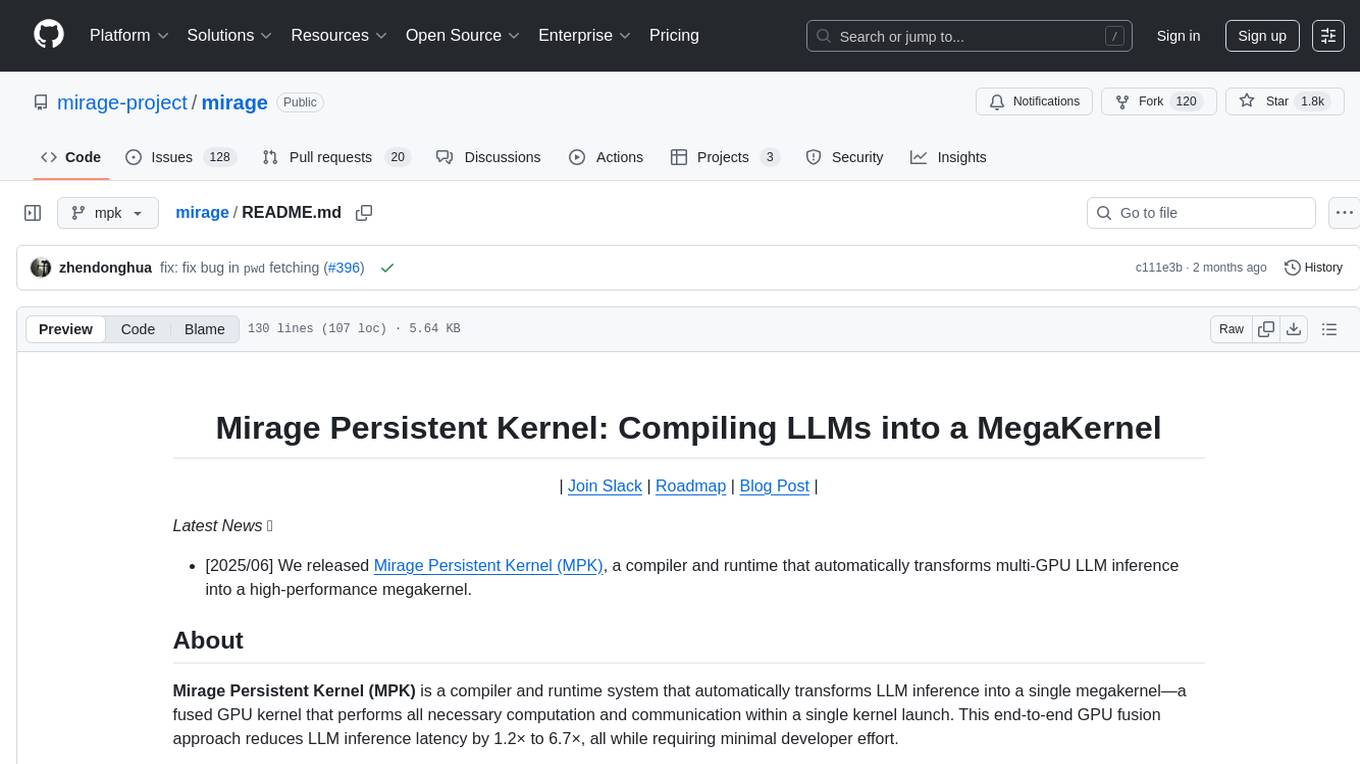
mirage
Mirage Persistent Kernel (MPK) is a compiler and runtime system that automatically transforms LLM inference into a single megakernel—a fused GPU kernel that performs all necessary computation and communication within a single kernel launch. This end-to-end GPU fusion approach reduces LLM inference latency by 1.2× to 6.7×, all while requiring minimal developer effort.
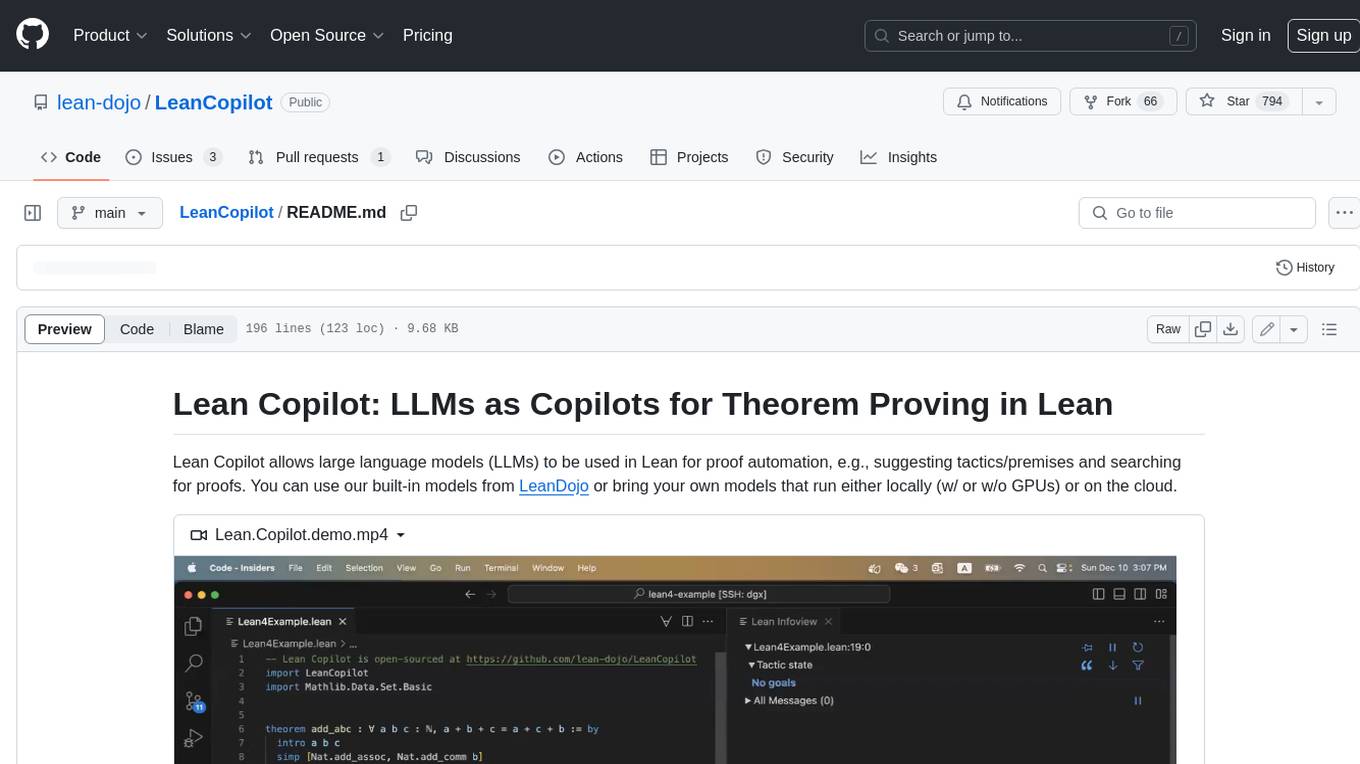
LeanCopilot
Lean Copilot is a tool that enables the use of large language models (LLMs) in Lean for proof automation. It provides features such as suggesting tactics/premises, searching for proofs, and running inference of LLMs. Users can utilize built-in models from LeanDojo or bring their own models to run locally or on the cloud. The tool supports platforms like Linux, macOS, and Windows WSL, with optional CUDA and cuDNN for GPU acceleration. Advanced users can customize behavior using Tactic APIs and Model APIs. Lean Copilot also allows users to bring their own models through ExternalGenerator or ExternalEncoder. The tool comes with caveats such as occasional crashes and issues with premise selection and proof search. Users can get in touch through GitHub Discussions for questions, bug reports, feature requests, and suggestions. The tool is designed to enhance theorem proving in Lean using LLMs.
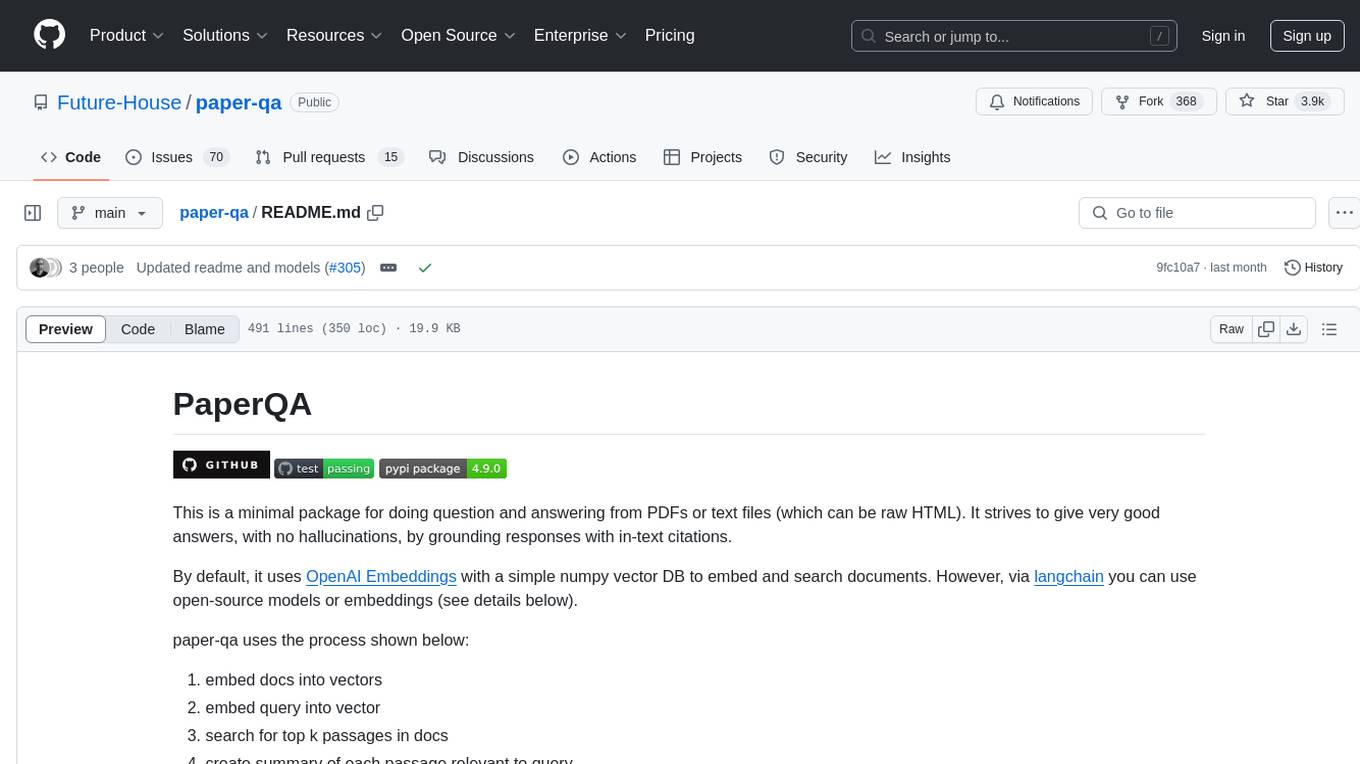
paper-qa
PaperQA is a minimal package for question and answering from PDFs or text files, providing very good answers with in-text citations. It uses OpenAI Embeddings to embed and search documents, and includes a process of embedding docs, queries, searching for top passages, creating summaries, using an LLM to re-score and select relevant summaries, putting summaries into prompt, and generating answers. The tool can be used to answer specific questions related to scientific research by leveraging citations and relevant passages from documents.
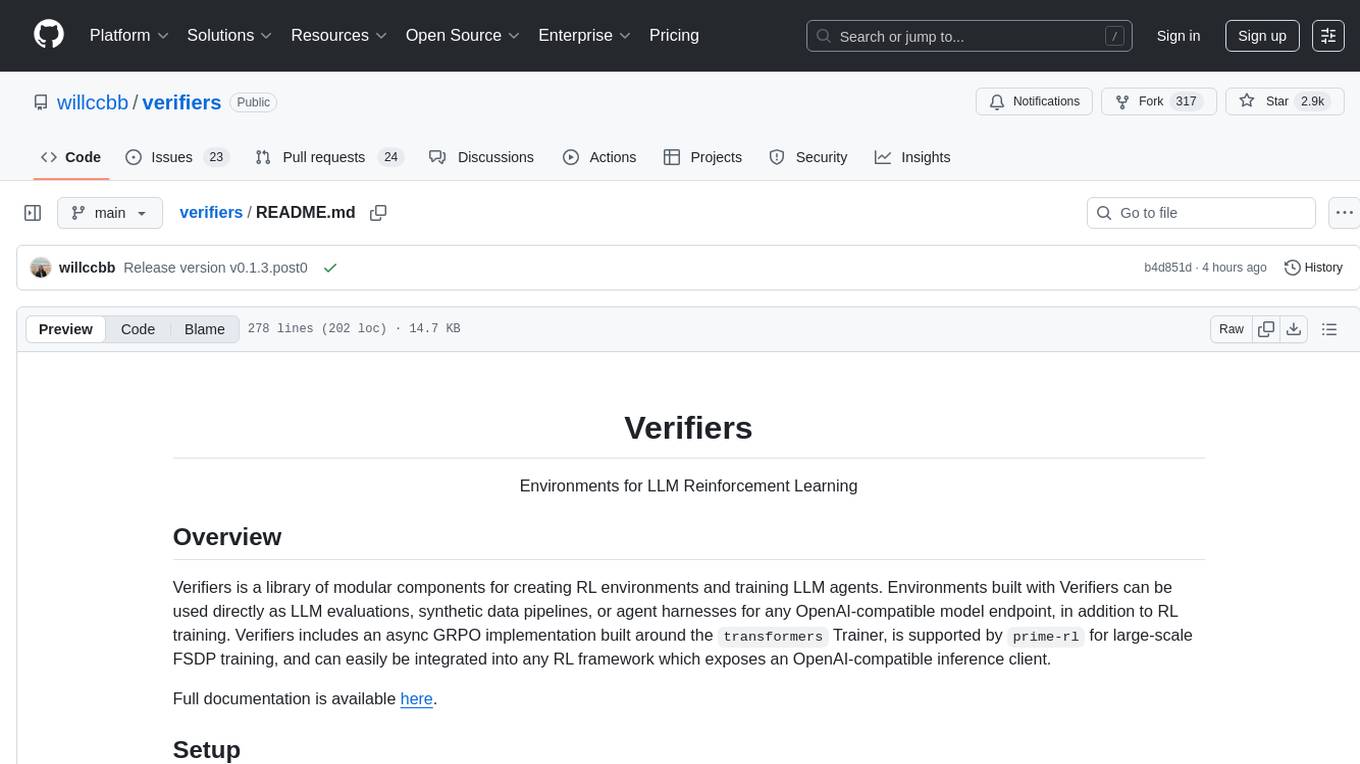
verifiers
Verifiers is a library of modular components for creating RL environments and training LLM agents. It includes an async GRPO implementation built around the `transformers` Trainer, is supported by `prime-rl` for large-scale FSDP training, and can easily be integrated into any RL framework which exposes an OpenAI-compatible inference client. The library provides tools for creating and evaluating RL environments, training LLM agents, and leveraging OpenAI-compatible models for various tasks. Verifiers aims to be a reliable toolkit for building on top of, minimizing fork proliferation in the RL infrastructure ecosystem.
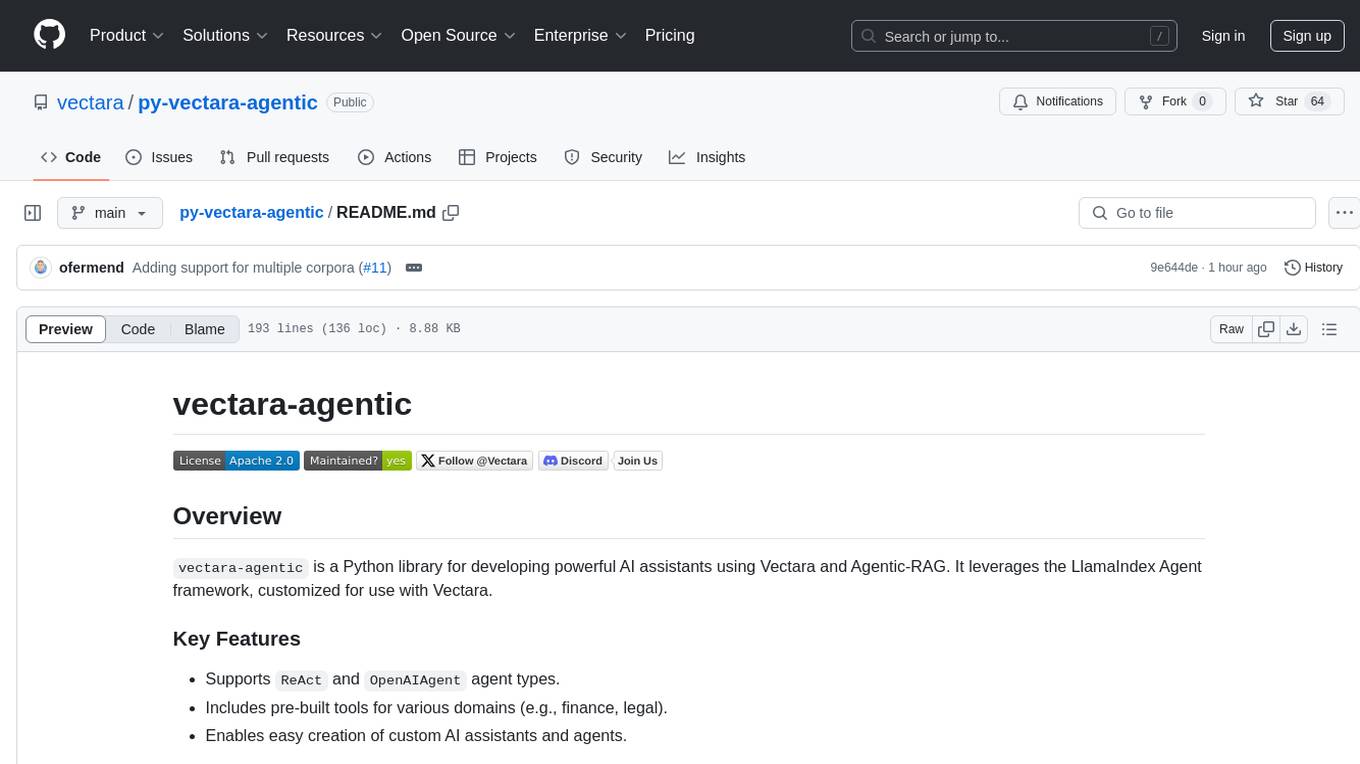
py-vectara-agentic
The `vectara-agentic` Python library is designed for developing powerful AI assistants using Vectara and Agentic-RAG. It supports various agent types, includes pre-built tools for domains like finance and legal, and enables easy creation of custom AI assistants and agents. The library provides tools for summarizing text, rephrasing text, legal tasks like summarizing legal text and critiquing as a judge, financial tasks like analyzing balance sheets and income statements, and database tools for inspecting and querying databases. It also supports observability via LlamaIndex and Arize Phoenix integration.
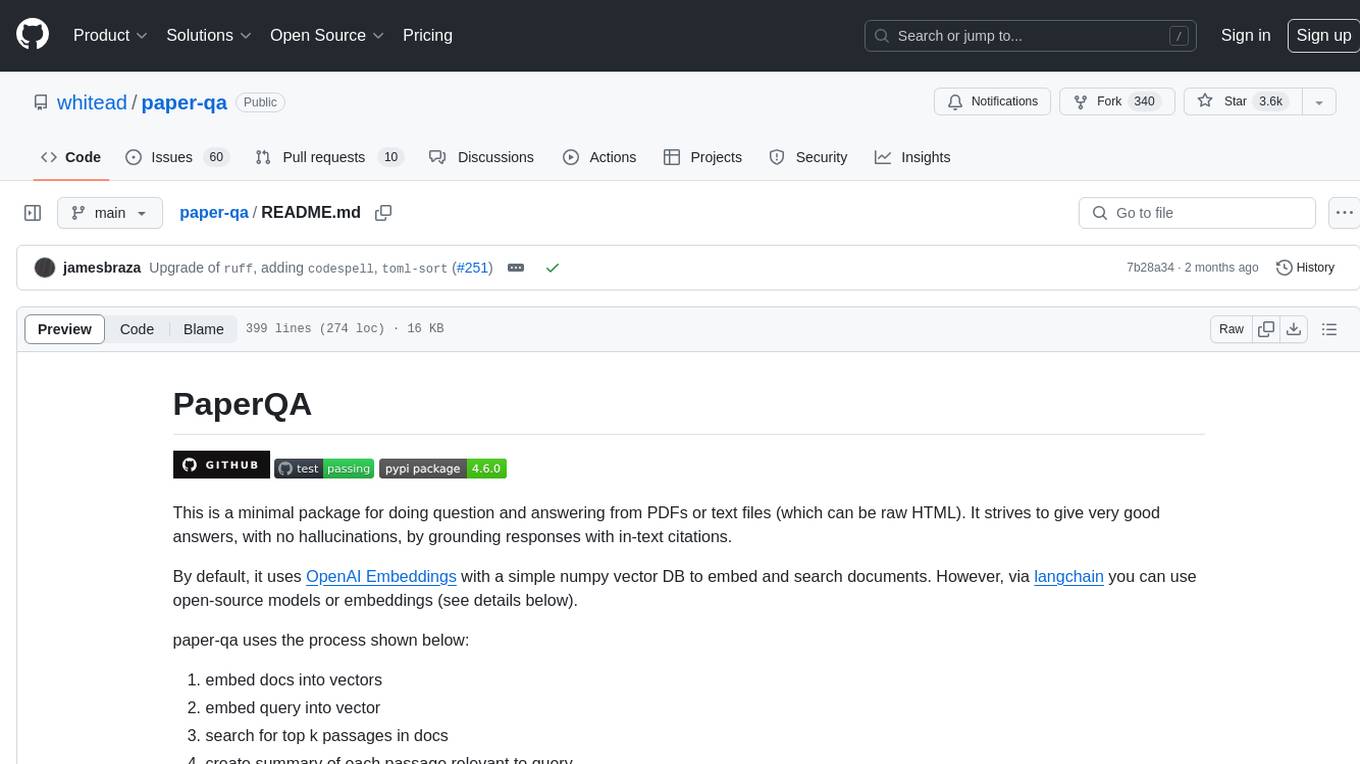
paper-qa
PaperQA is a minimal package for question and answering from PDFs or text files, providing very good answers with in-text citations. It uses OpenAI Embeddings to embed and search documents, and follows a process of embedding docs and queries, searching for top passages, creating summaries, scoring and selecting relevant summaries, putting summaries into prompt, and generating answers. Users can customize prompts and use various models for embeddings and LLMs. The tool can be used asynchronously and supports adding documents from paths, files, or URLs.
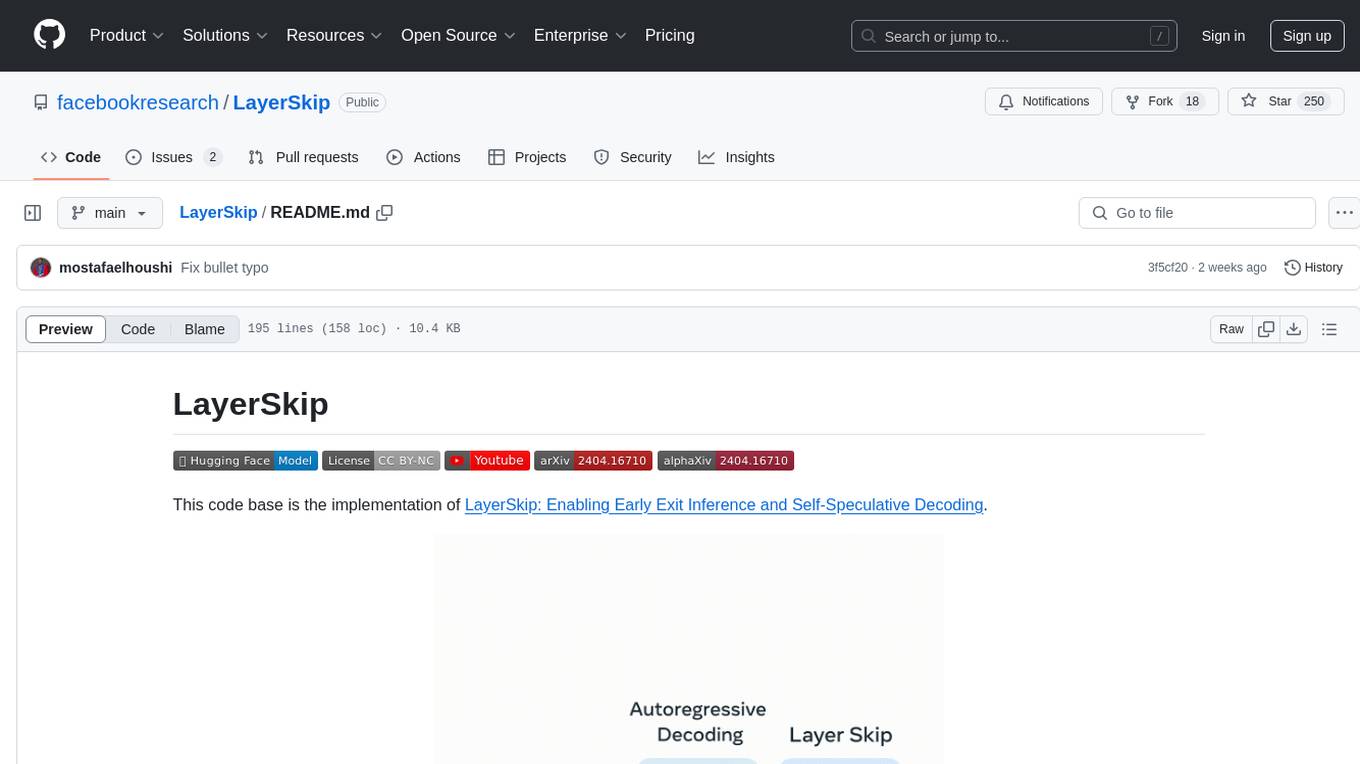
LayerSkip
LayerSkip is an implementation enabling early exit inference and self-speculative decoding. It provides a code base for running models trained using the LayerSkip recipe, offering speedup through self-speculative decoding. The tool integrates with Hugging Face transformers and provides checkpoints for various LLMs. Users can generate tokens, benchmark on datasets, evaluate tasks, and sweep over hyperparameters to optimize inference speed. The tool also includes correctness verification scripts and Docker setup instructions. Additionally, other implementations like gpt-fast and Native HuggingFace are available. Training implementation is a work-in-progress, and contributions are welcome under the CC BY-NC license.
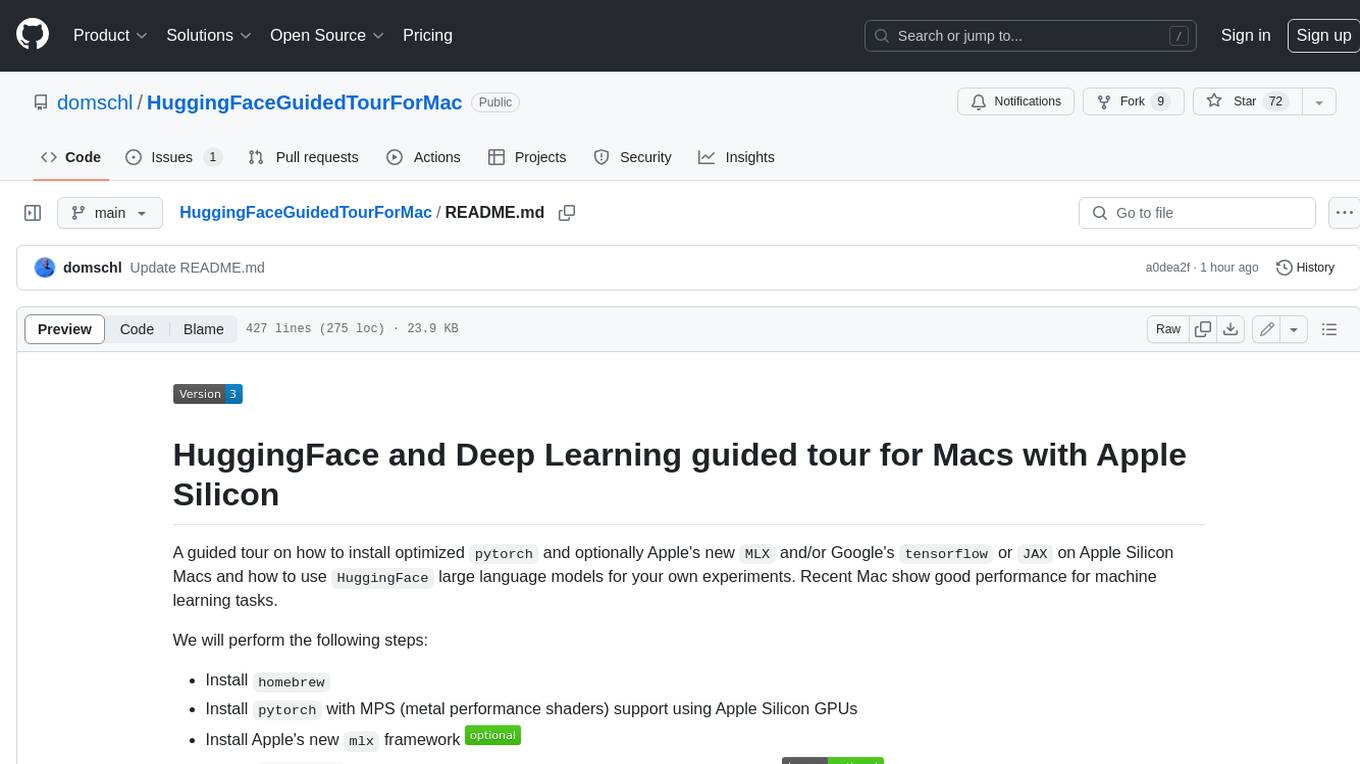
HuggingFaceGuidedTourForMac
HuggingFaceGuidedTourForMac is a guided tour on how to install optimized pytorch and optionally Apple's new MLX, JAX, and TensorFlow on Apple Silicon Macs. The repository provides steps to install homebrew, pytorch with MPS support, MLX, JAX, TensorFlow, and Jupyter lab. It also includes instructions on running large language models using HuggingFace transformers. The repository aims to help users set up their Macs for deep learning experiments with optimized performance.
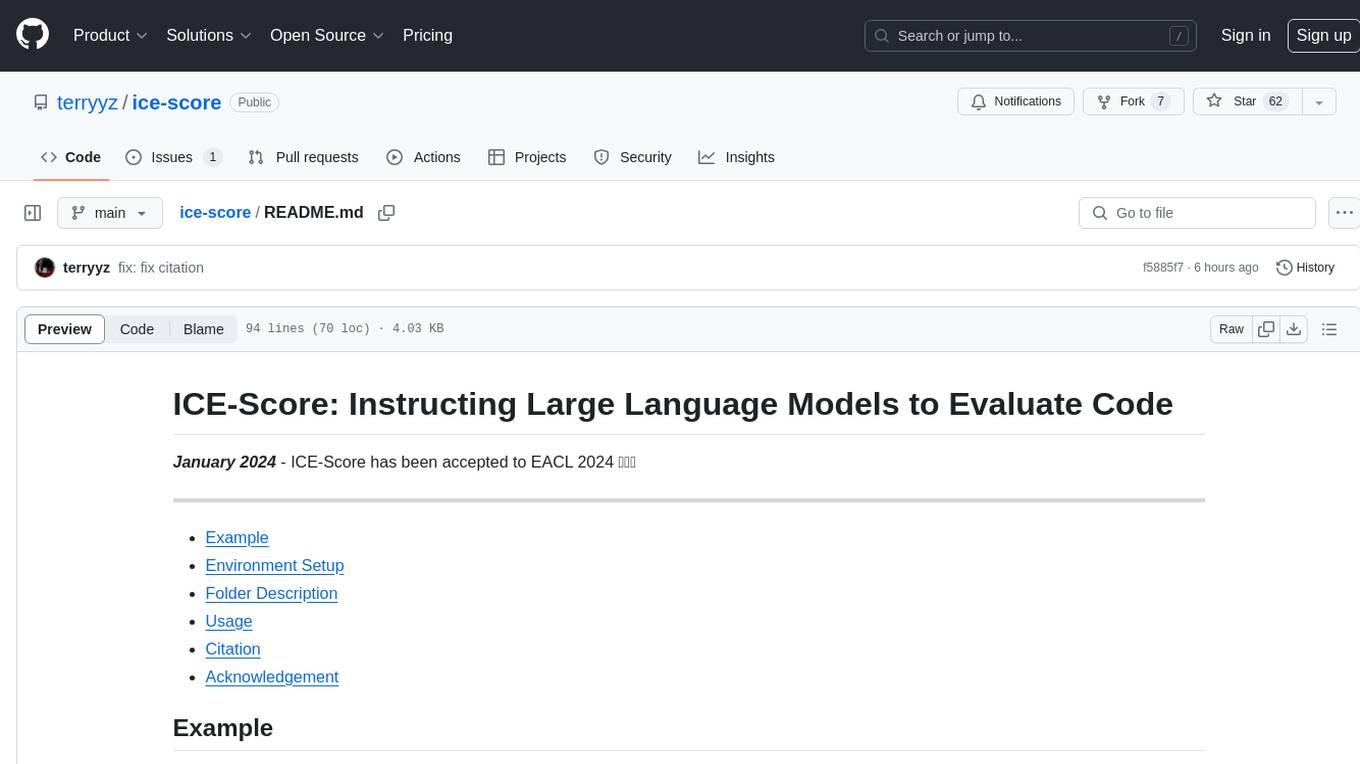
ice-score
ICE-Score is a tool designed to instruct large language models to evaluate code. It provides a minimum viable product (MVP) for evaluating generated code snippets using inputs such as problem, output, task, aspect, and model. Users can also evaluate with reference code and enable zero-shot chain-of-thought evaluation. The tool is built on codegen-metrics and code-bert-score repositories and includes datasets like CoNaLa and HumanEval. ICE-Score has been accepted to EACL 2024.
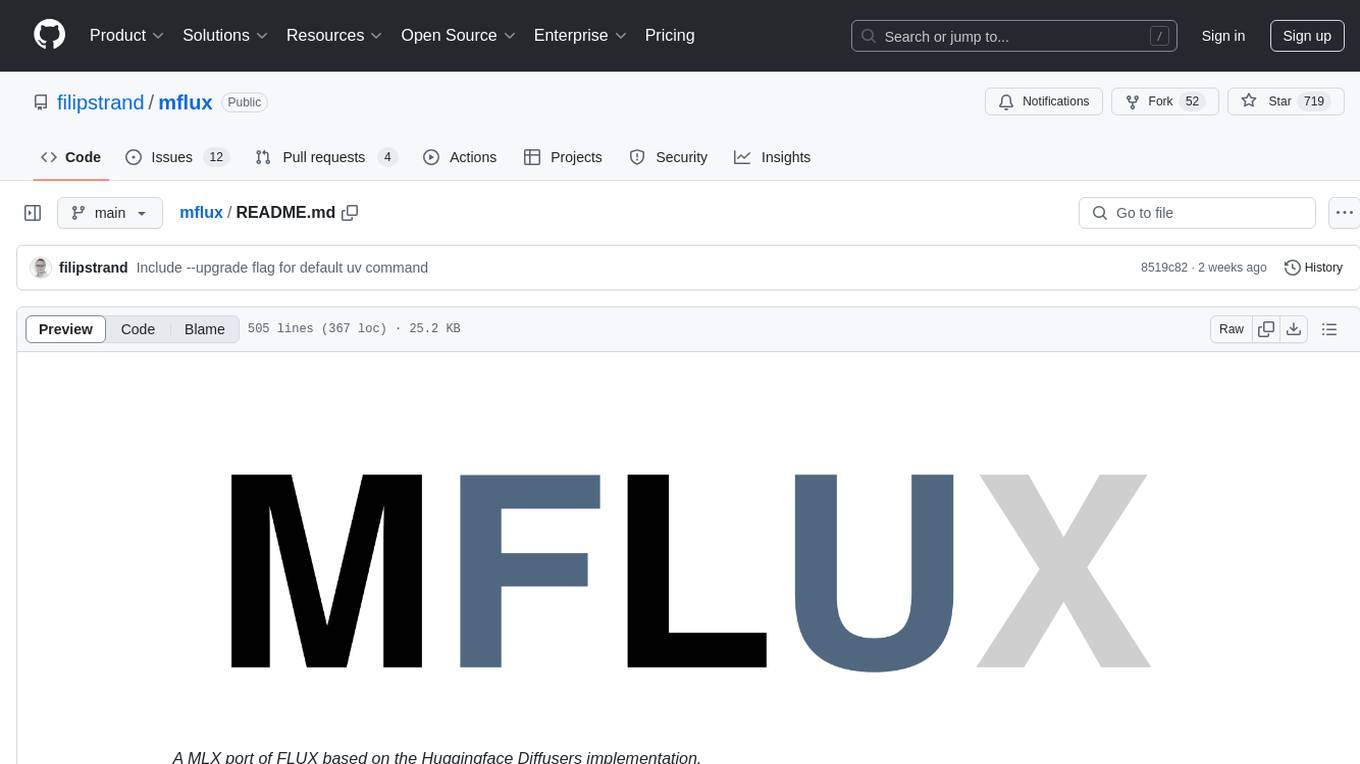
mflux
MFLUX is a line-by-line port of the FLUX implementation in the Huggingface Diffusers library to Apple MLX. It aims to run powerful FLUX models from Black Forest Labs locally on Mac machines. The codebase is minimal and explicit, prioritizing readability over generality and performance. Models are implemented from scratch in MLX, with tokenizers from the Huggingface Transformers library. Dependencies include Numpy and Pillow for image post-processing. Installation can be done using `uv tool` or classic virtual environment setup. Command-line arguments allow for image generation with specified models, prompts, and optional parameters. Quantization options for speed and memory reduction are available. LoRA adapters can be loaded for fine-tuning image generation. Controlnet support provides more control over image generation with reference images. Current limitations include generating images one by one, lack of support for negative prompts, and some LoRA adapters not working.
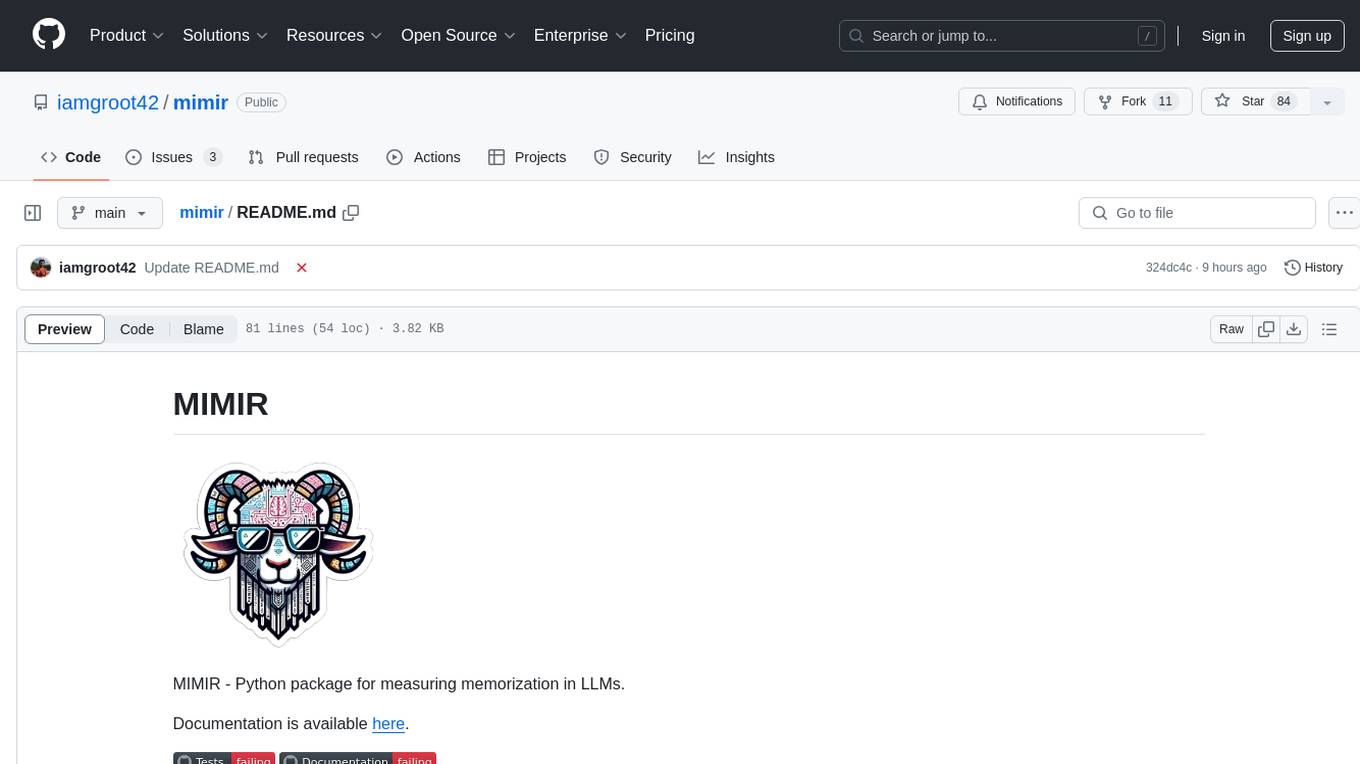
mimir
MIMIR is a Python package designed for measuring memorization in Large Language Models (LLMs). It provides functionalities for conducting experiments related to membership inference attacks on LLMs. The package includes implementations of various attacks such as Likelihood, Reference-based, Zlib Entropy, Neighborhood, Min-K% Prob, Min-K%++, Gradient Norm, and allows users to extend it by adding their own datasets and attacks.
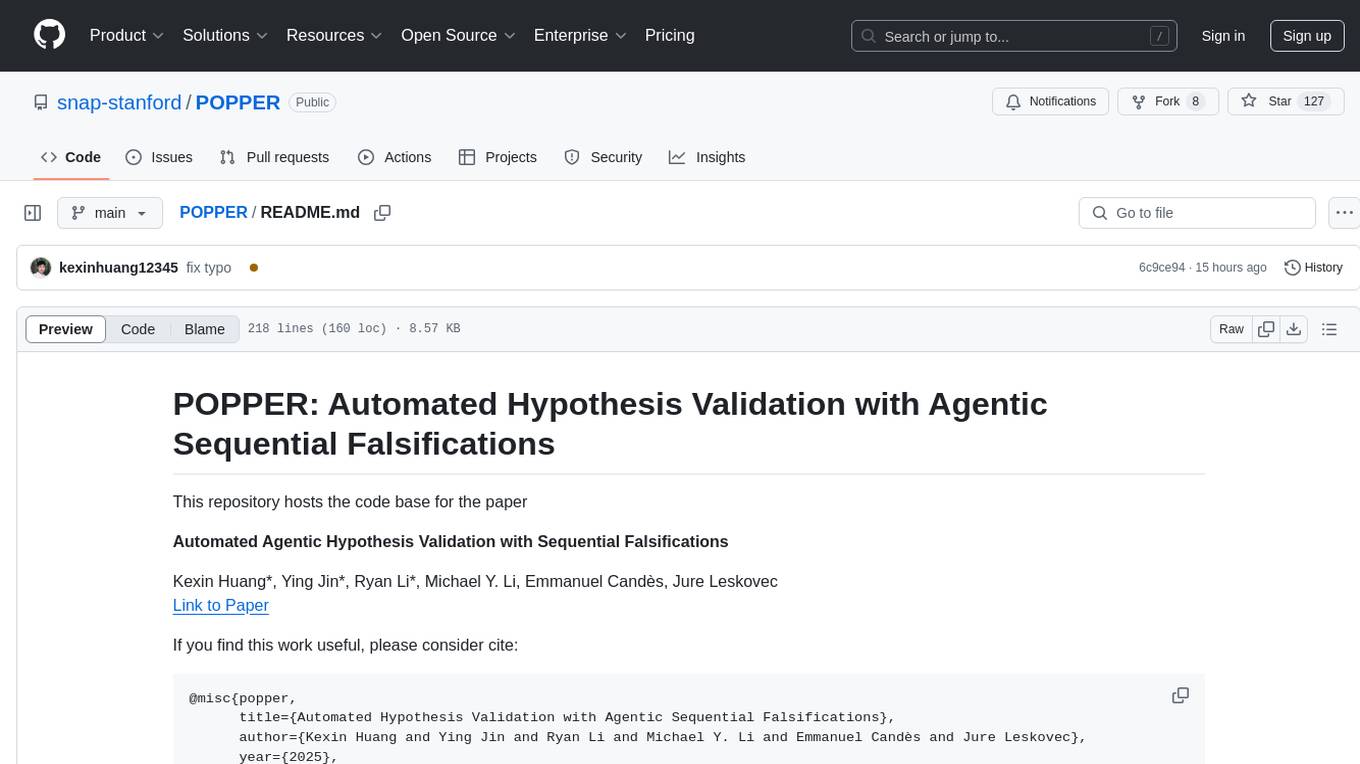
POPPER
Popper is an agentic framework for automated validation of free-form hypotheses using Large Language Models (LLMs). It follows Karl Popper's principle of falsification and designs falsification experiments to validate hypotheses. Popper ensures strict Type-I error control and actively gathers evidence from diverse observations. It delivers robust error control, high power, and scalability across various domains like biology, economics, and sociology. Compared to human scientists, Popper achieves comparable performance in validating complex biological hypotheses while reducing time by 10 folds, providing a scalable, rigorous solution for hypothesis validation.
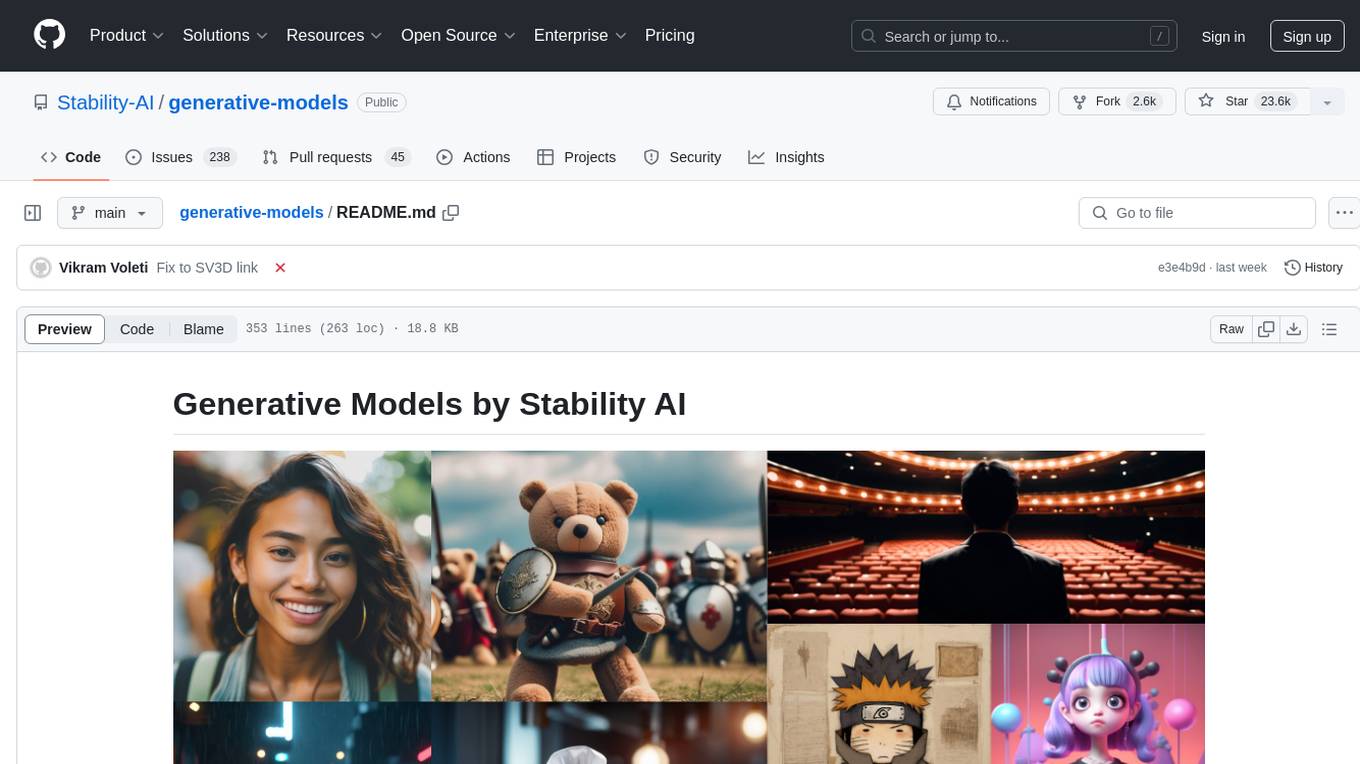
generative-models
Generative Models by Stability AI is a repository that provides various generative models for research purposes. It includes models like Stable Video 4D (SV4D) for video synthesis, Stable Video 3D (SV3D) for multi-view synthesis, SDXL-Turbo for text-to-image generation, and more. The repository focuses on modularity and implements a config-driven approach for building and combining submodules. It supports training with PyTorch Lightning and offers inference demos for different models. Users can access pre-trained models like SDXL-base-1.0 and SDXL-refiner-1.0 under a CreativeML Open RAIL++-M license. The codebase also includes tools for invisible watermark detection in generated images.
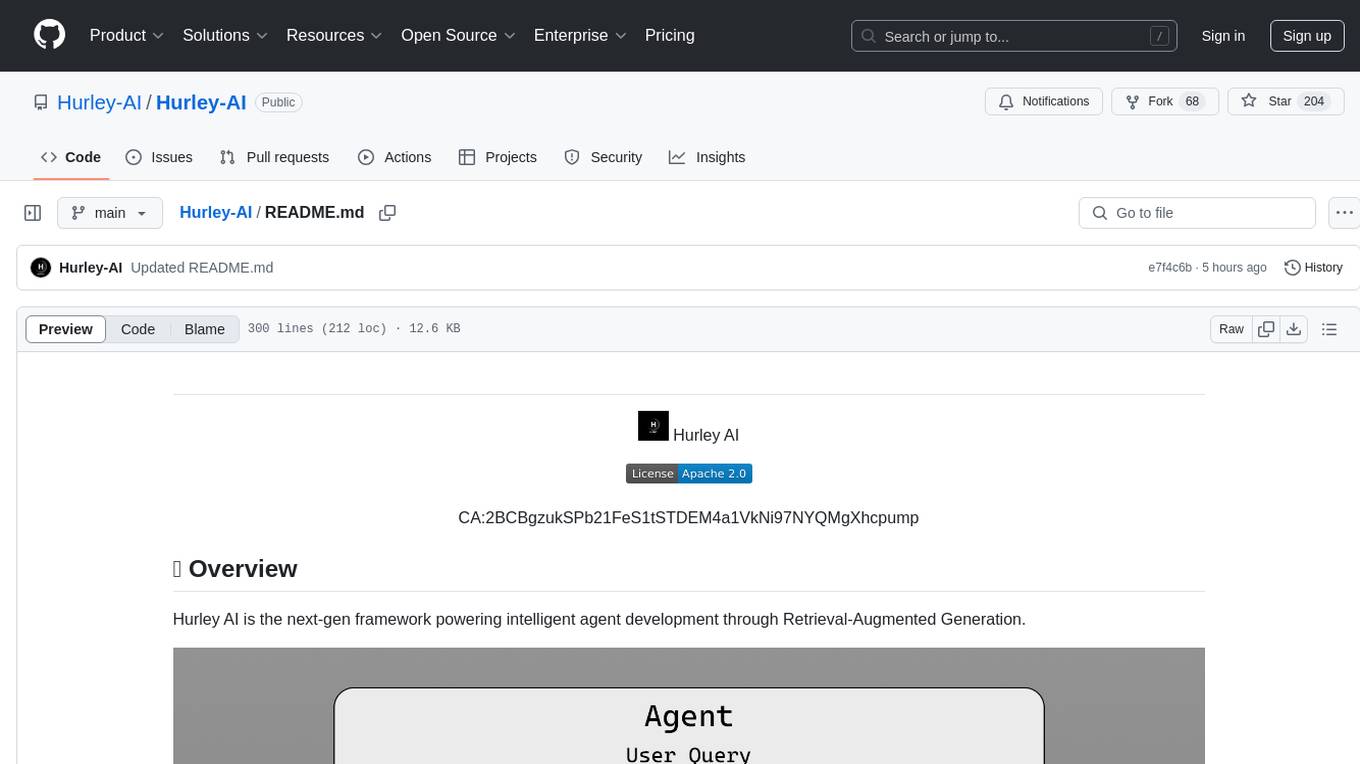
Hurley-AI
Hurley AI is a next-gen framework for developing intelligent agents through Retrieval-Augmented Generation. It enables easy creation of custom AI assistants and agents, supports various agent types, and includes pre-built tools for domains like finance and legal. Hurley AI integrates with LLM inference services and provides observability with Arize Phoenix. Users can create Hurley RAG tools with a single line of code and customize agents with specific instructions. The tool also offers various helper functions to connect with Hurley RAG and search tools, along with pre-built tools for tasks like summarizing text, rephrasing text, understanding memecoins, and querying databases.
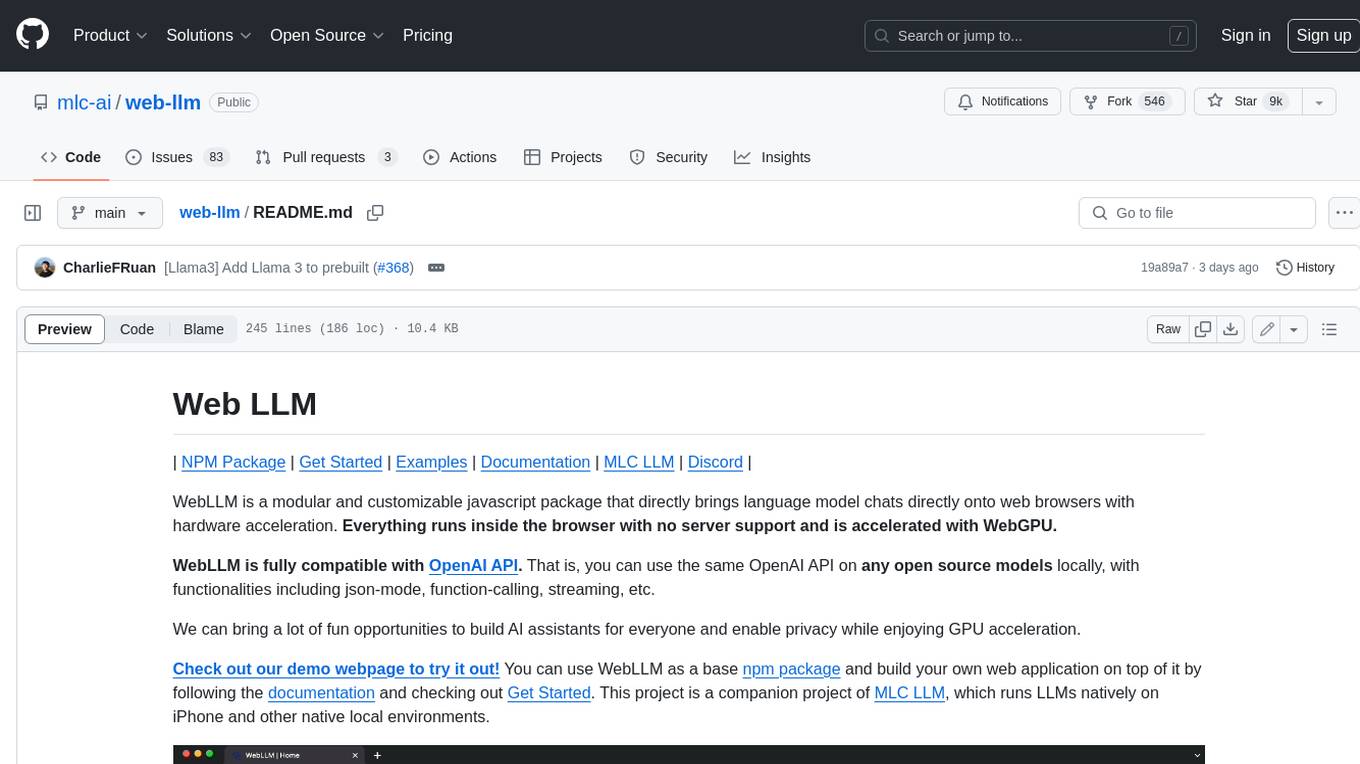
web-llm
WebLLM is a modular and customizable javascript package that directly brings language model chats directly onto web browsers with hardware acceleration. Everything runs inside the browser with no server support and is accelerated with WebGPU. WebLLM is fully compatible with OpenAI API. That is, you can use the same OpenAI API on any open source models locally, with functionalities including json-mode, function-calling, streaming, etc. We can bring a lot of fun opportunities to build AI assistants for everyone and enable privacy while enjoying GPU acceleration.
For similar tasks

kvpress
This repository implements multiple key-value cache pruning methods and benchmarks using transformers, aiming to simplify the development of new methods for researchers and developers in the field of long-context language models. It provides a set of 'presses' that compress the cache during the pre-filling phase, with each press having a compression ratio attribute. The repository includes various training-free presses, special presses, and supports KV cache quantization. Users can contribute new presses and evaluate the performance of different presses on long-context datasets.
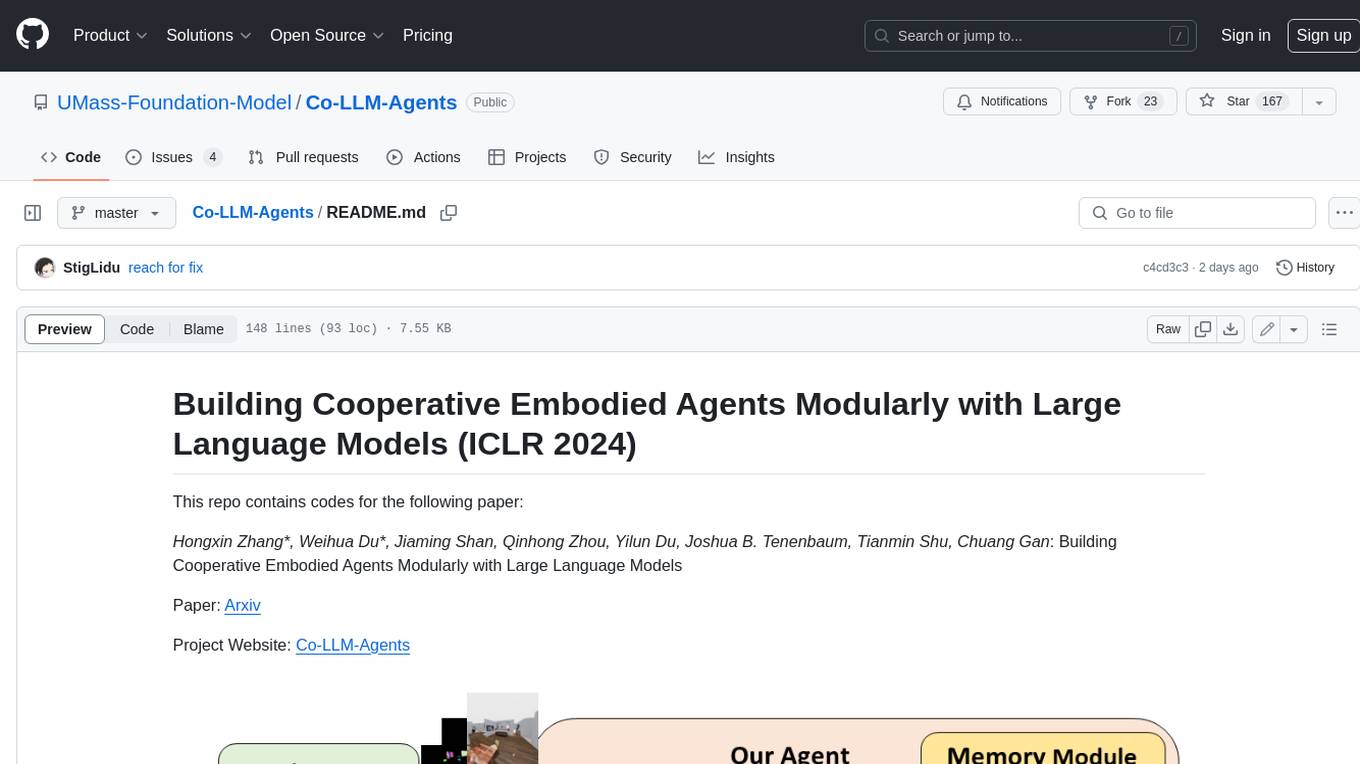
Co-LLM-Agents
This repository contains code for building cooperative embodied agents modularly with large language models. The agents are trained to perform tasks in two different environments: ThreeDWorld Multi-Agent Transport (TDW-MAT) and Communicative Watch-And-Help (C-WAH). TDW-MAT is a multi-agent environment where agents must transport objects to a goal position using containers. C-WAH is an extension of the Watch-And-Help challenge, which enables agents to send messages to each other. The code in this repository can be used to train agents to perform tasks in both of these environments.
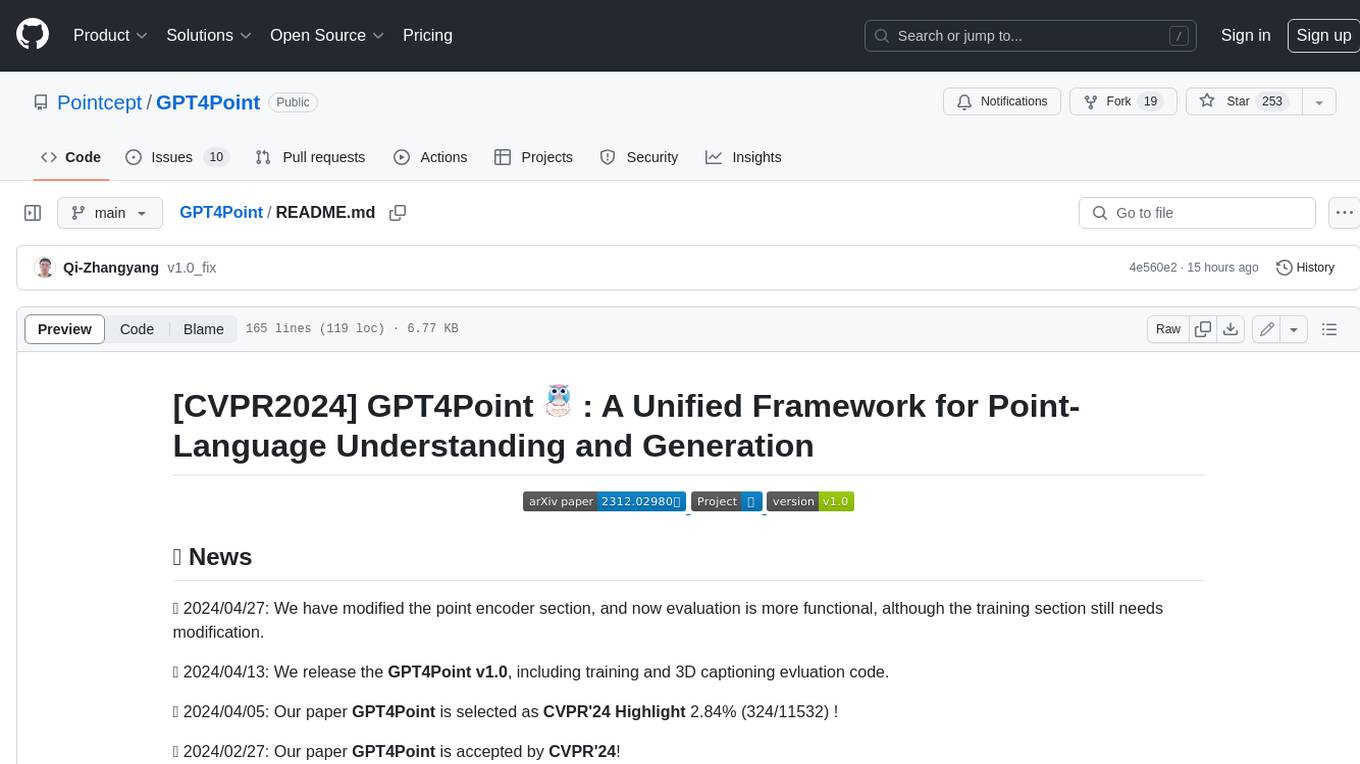
GPT4Point
GPT4Point is a unified framework for point-language understanding and generation. It aligns 3D point clouds with language, providing a comprehensive solution for tasks such as 3D captioning and controlled 3D generation. The project includes an automated point-language dataset annotation engine, a novel object-level point cloud benchmark, and a 3D multi-modality model. Users can train and evaluate models using the provided code and datasets, with a focus on improving models' understanding capabilities and facilitating the generation of 3D objects.
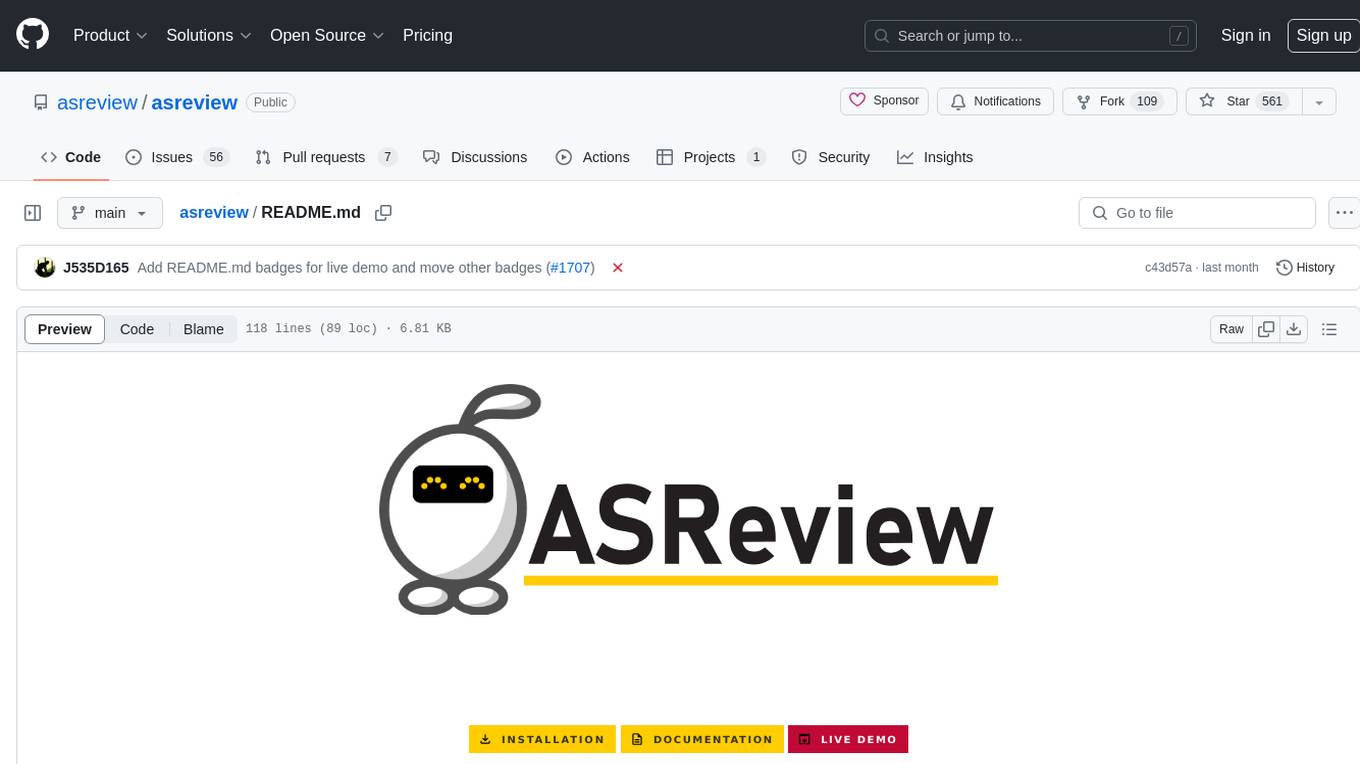
asreview
The ASReview project implements active learning for systematic reviews, utilizing AI-aided pipelines to assist in finding relevant texts for search tasks. It accelerates the screening of textual data with minimal human input, saving time and increasing output quality. The software offers three modes: Oracle for interactive screening, Exploration for teaching purposes, and Simulation for evaluating active learning models. ASReview LAB is designed to support decision-making in any discipline or industry by improving efficiency and transparency in screening large amounts of textual data.
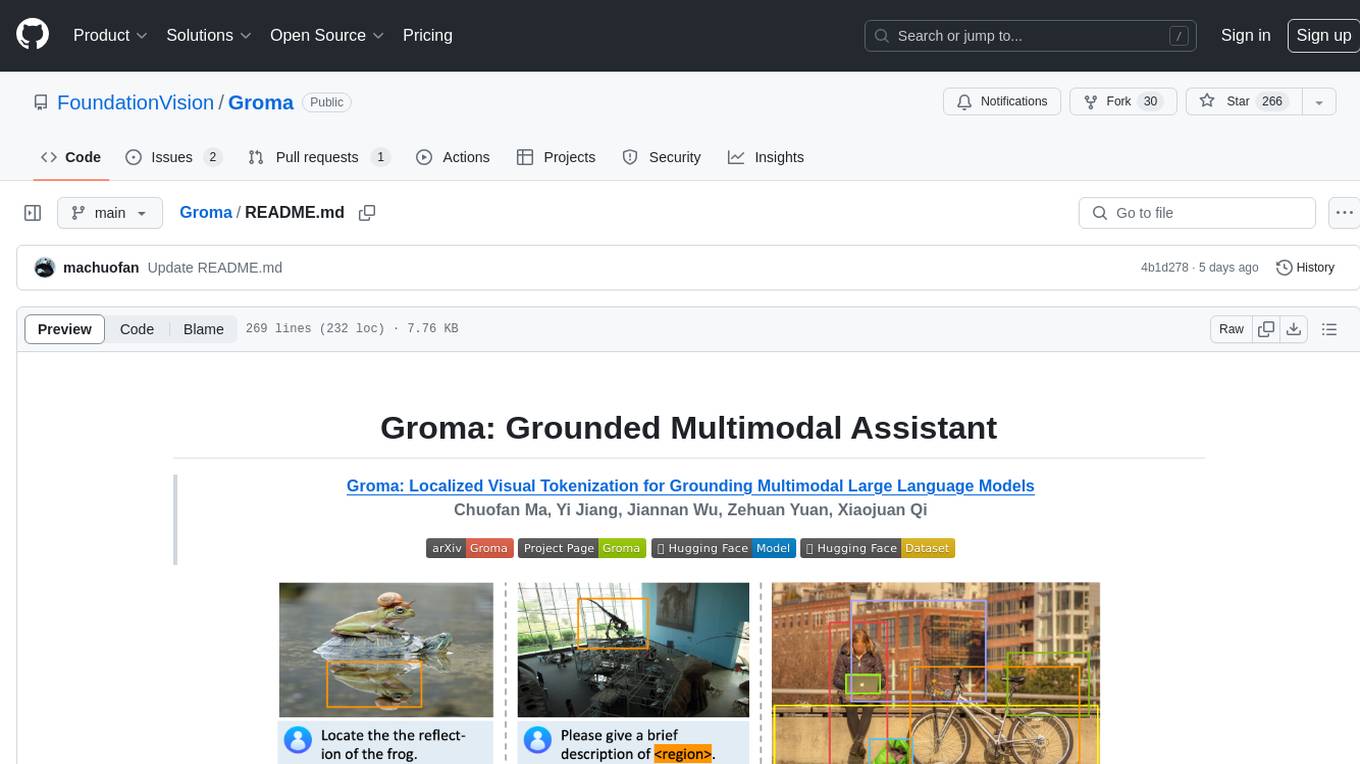
Groma
Groma is a grounded multimodal assistant that excels in region understanding and visual grounding. It can process user-defined region inputs and generate contextually grounded long-form responses. The tool presents a unique paradigm for multimodal large language models, focusing on visual tokenization for localization. Groma achieves state-of-the-art performance in referring expression comprehension benchmarks. The tool provides pretrained model weights and instructions for data preparation, training, inference, and evaluation. Users can customize training by starting from intermediate checkpoints. Groma is designed to handle tasks related to detection pretraining, alignment pretraining, instruction finetuning, instruction following, and more.
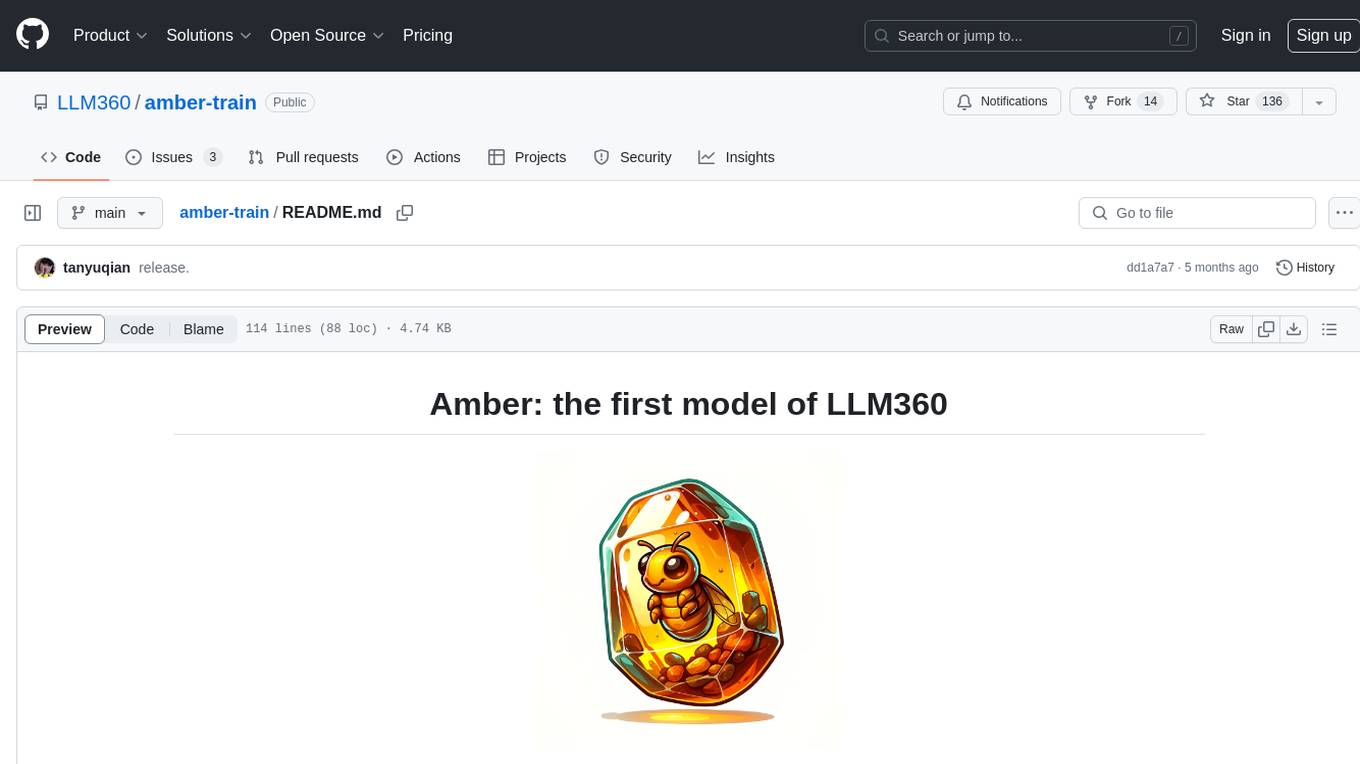
amber-train
Amber is the first model in the LLM360 family, an initiative for comprehensive and fully open-sourced LLMs. It is a 7B English language model with the LLaMA architecture. The model type is a language model with the same architecture as LLaMA-7B. It is licensed under Apache 2.0. The resources available include training code, data preparation, metrics, and fully processed Amber pretraining data. The model has been trained on various datasets like Arxiv, Book, C4, Refined-Web, StarCoder, StackExchange, and Wikipedia. The hyperparameters include a total of 6.7B parameters, hidden size of 4096, intermediate size of 11008, 32 attention heads, 32 hidden layers, RMSNorm ε of 1e^-6, max sequence length of 2048, and a vocabulary size of 32000.
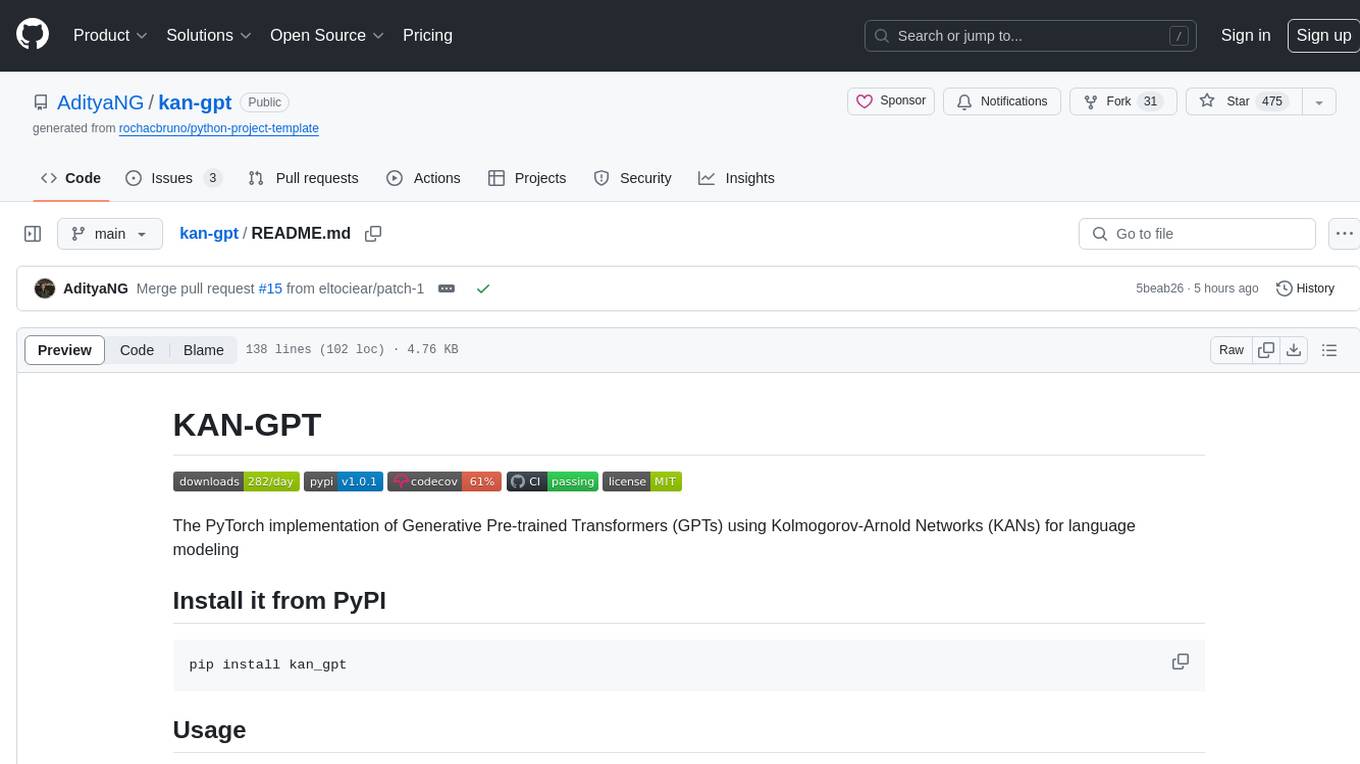
kan-gpt
The KAN-GPT repository is a PyTorch implementation of Generative Pre-trained Transformers (GPTs) using Kolmogorov-Arnold Networks (KANs) for language modeling. It provides a model for generating text based on prompts, with a focus on improving performance compared to traditional MLP-GPT models. The repository includes scripts for training the model, downloading datasets, and evaluating model performance. Development tasks include integrating with other libraries, testing, and documentation.
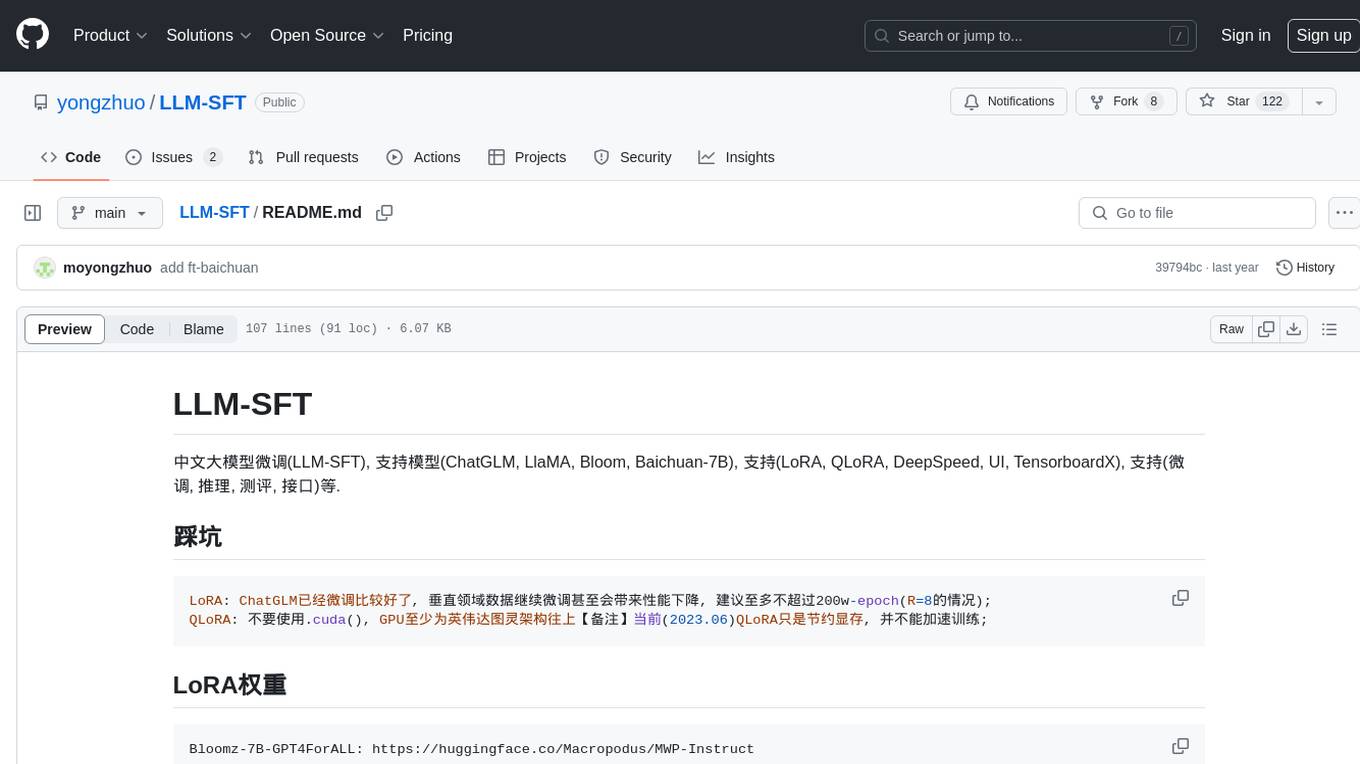
LLM-SFT
LLM-SFT is a Chinese large model fine-tuning tool that supports models such as ChatGLM, LlaMA, Bloom, Baichuan-7B, and frameworks like LoRA, QLoRA, DeepSpeed, UI, and TensorboardX. It facilitates tasks like fine-tuning, inference, evaluation, and API integration. The tool provides pre-trained weights for various models and datasets for Chinese language processing. It requires specific versions of libraries like transformers and torch for different functionalities.
For similar jobs

weave
Weave is a toolkit for developing Generative AI applications, built by Weights & Biases. With Weave, you can log and debug language model inputs, outputs, and traces; build rigorous, apples-to-apples evaluations for language model use cases; and organize all the information generated across the LLM workflow, from experimentation to evaluations to production. Weave aims to bring rigor, best-practices, and composability to the inherently experimental process of developing Generative AI software, without introducing cognitive overhead.

LLMStack
LLMStack is a no-code platform for building generative AI agents, workflows, and chatbots. It allows users to connect their own data, internal tools, and GPT-powered models without any coding experience. LLMStack can be deployed to the cloud or on-premise and can be accessed via HTTP API or triggered from Slack or Discord.

VisionCraft
The VisionCraft API is a free API for using over 100 different AI models. From images to sound.

kaito
Kaito is an operator that automates the AI/ML inference model deployment in a Kubernetes cluster. It manages large model files using container images, avoids tuning deployment parameters to fit GPU hardware by providing preset configurations, auto-provisions GPU nodes based on model requirements, and hosts large model images in the public Microsoft Container Registry (MCR) if the license allows. Using Kaito, the workflow of onboarding large AI inference models in Kubernetes is largely simplified.

PyRIT
PyRIT is an open access automation framework designed to empower security professionals and ML engineers to red team foundation models and their applications. It automates AI Red Teaming tasks to allow operators to focus on more complicated and time-consuming tasks and can also identify security harms such as misuse (e.g., malware generation, jailbreaking), and privacy harms (e.g., identity theft). The goal is to allow researchers to have a baseline of how well their model and entire inference pipeline is doing against different harm categories and to be able to compare that baseline to future iterations of their model. This allows them to have empirical data on how well their model is doing today, and detect any degradation of performance based on future improvements.

tabby
Tabby is a self-hosted AI coding assistant, offering an open-source and on-premises alternative to GitHub Copilot. It boasts several key features: * Self-contained, with no need for a DBMS or cloud service. * OpenAPI interface, easy to integrate with existing infrastructure (e.g Cloud IDE). * Supports consumer-grade GPUs.

spear
SPEAR (Simulator for Photorealistic Embodied AI Research) is a powerful tool for training embodied agents. It features 300 unique virtual indoor environments with 2,566 unique rooms and 17,234 unique objects that can be manipulated individually. Each environment is designed by a professional artist and features detailed geometry, photorealistic materials, and a unique floor plan and object layout. SPEAR is implemented as Unreal Engine assets and provides an OpenAI Gym interface for interacting with the environments via Python.

Magick
Magick is a groundbreaking visual AIDE (Artificial Intelligence Development Environment) for no-code data pipelines and multimodal agents. Magick can connect to other services and comes with nodes and templates well-suited for intelligent agents, chatbots, complex reasoning systems and realistic characters.





